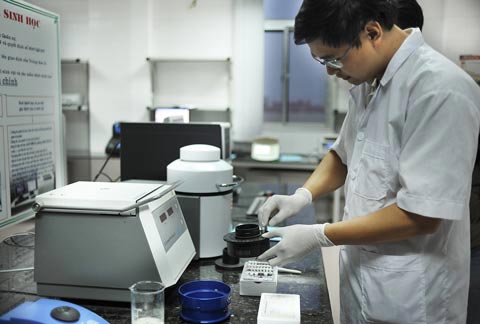Early detection of cancer by virus test
After only two days of testing, scientists at the Military Medical Academy can detect HPV (human pallpiloma), the leading cause of cervical cancer in women.
Since the beginning of 2009, the research team, including Dr. Tran Van Khoa, Dr. Nguyen Linh Toan and Bachelor of Trieu Tien Sang, have been taking samples of cells in the cervix to separate DNA. Next, scientists use a specific 'bait' to amplify the HPV virus gene.
The product after amplification is put into the electrophoresis to detect if the person is infected with HPV. When HPV infection was detected, scientists continued to use specific primer pairs to amplify the HPV gene sequence to determine if HPV type is at high risk of cervical cancer.
The results of this study were applied by Military Medical Academy to patients who came to the Department of Obstetrics and Gynecology Hospital 103. Up to now, there have been more than 60 cases of HPV testing, of which about 10-20% high risk of HPV infection.

HPV test for early detection of cervical cancer in the Military Medical Academy. Photo: Duc Long
According to Dr. Khoa, cervical cancer is one of two types of cancer that Vietnamese women are most affected. This disease usually occurs when there are additional factors such as premature sex or with many people, immunodeficiency, birth, abortion or miscarriage many times . These injuries facilitate the virus. HPV is more accessible to cervical cell layer.
When invading, HPV causes these cells to change and over the years, the cells become malignant. The process from virus infection to cancer is usually very long, from mild, moderate, severe dysplasia to local cancer to invasive cancer, if early detection of HPV virus can take measures to avoid risk. cancer.
Currently, the Military Medical Academy is proposing to include HPV testing in the list of health insurance payments, helping women have the opportunity to test, early diagnosis and prevention of cervical cancer.
- Tests help detect cancer early
- Warning of early use of cancer detection strips
- Liquid biopsy: The dream of the world's most prominent oncologist
- New test methods help detect nasal cancer earlier
- Rapid detection of cancer with test strips
- Early detection of male cancer should not be overlooked
- Google developed a cancer detection device
- Early detection of ovarian cancer thanks to regular blood tests
- Detection of the H5N1 virus strain by a test
- Find out how to detect cancer early
- Manufacturing equipment for early diagnosis of throat cancer
- Find out how to detect ovarian cancer early
 Green tea cleans teeth better than mouthwash?
Green tea cleans teeth better than mouthwash? Death kiss: This is why you should not let anyone kiss your baby's lips
Death kiss: This is why you should not let anyone kiss your baby's lips What is salmonellosis?
What is salmonellosis? Caution should be exercised when using aloe vera through eating and drinking
Caution should be exercised when using aloe vera through eating and drinking